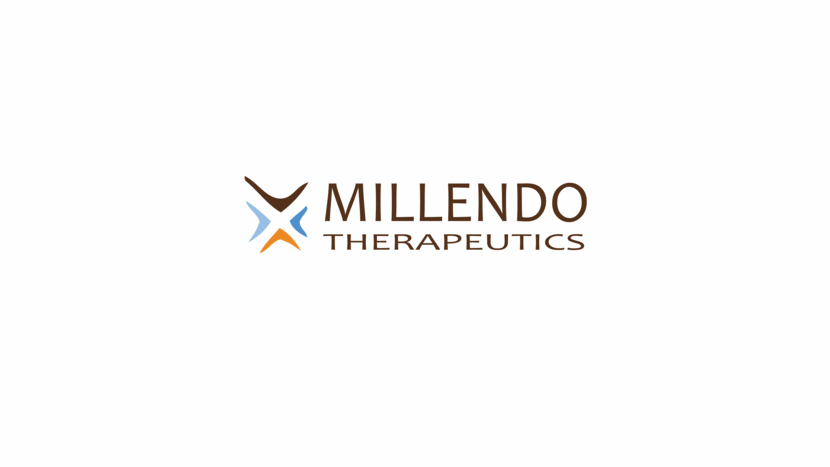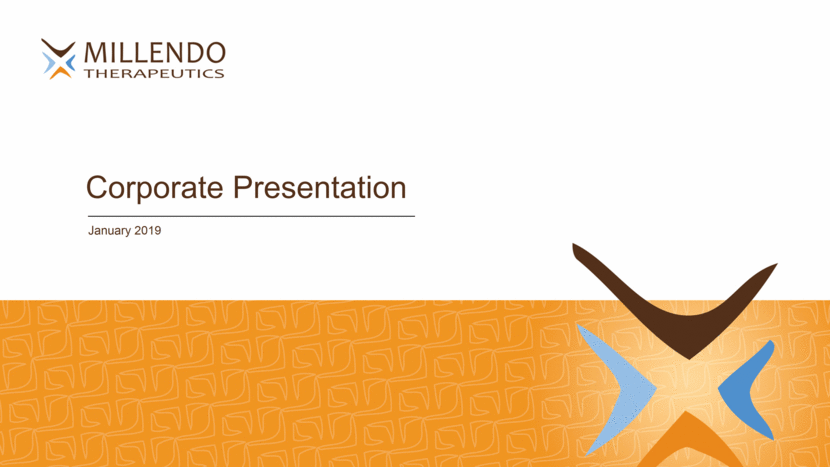Attached files
| file | filename |
|---|---|
| 8-K - 8-K - Tempest Therapeutics, Inc. | a19-1314_18k.htm |
2 Cautionary Statement Regarding Forward-Looking Statements Certain statements contained in this presentation regarding matters that are not historical facts, are forward-looking statements within the meaning of Section 21E of the Securities Exchange Act of 1934, as amended, and the Private Securities Litigation Reform Act of 1995, known as the PSLRA. These include statements regarding management’s intentions, plans, beliefs, expectations or forecasts for the future, and, therefore, you are cautioned not to place undue reliance on them. No forward-looking statement can be guaranteed, and actual results may differ materially from those projected. Millendo undertakes no obligation to publicly update any forward-looking statement, whether as a result of new information, future events or otherwise, except to the extent required by law. Millendo uses words such as “anticipates,” “believes,” “plans,” “expects,” “projects,” “future,” “intends,” “may,” “will,” “should,” “could,” “estimates,” “predicts,” “potential,” “continue,” “guidance,” and similar expressions to identify these forward-looking statements that are intended to be covered by the safe-harbor provisions of the PSLRA. Such forward-looking statements are based on Millendo’s expectations and involve risks and uncertainties; consequently, actual results may differ materially from those expressed or implied in the statements due to a number of factors, including Millendo’s plans to develop and commercialize its product candidates, including livoletide and nevanimibe; the timing of initiation of Millendo’s planned clinical trials; the timing of the availability of data from Millendo’s clinical trials; the timing of any planned investigational new drug application or new drug application; Millendo’s plans to research, develop and commercialize its current and future product candidates; the clinical utility, potential benefits and market acceptance of Millendo’s product candidates; Millendo’s commercialization, marketing and manufacturing capabilities and strategy; Millendo’s ability to protect its intellectual property position; and Millendo’s estimates regarding future revenue, expenses, capital requirements and need for additional financing. New factors emerge from time to time and it is not possible for Millendo to predict all such factors, nor can Millendo assess the impact of each such factor on the business or the extent to which any factor, or combination of factors, may cause actual results to differ materially from those contained in any forward-looking statements. Forward-looking statements included in this presentation are based on information available to Millendo as of the date of this presentation. Millendo disclaims any obligation to update such forward-looking statements to reflect events or circumstances after the date of this presentation, except as required by applicable law.
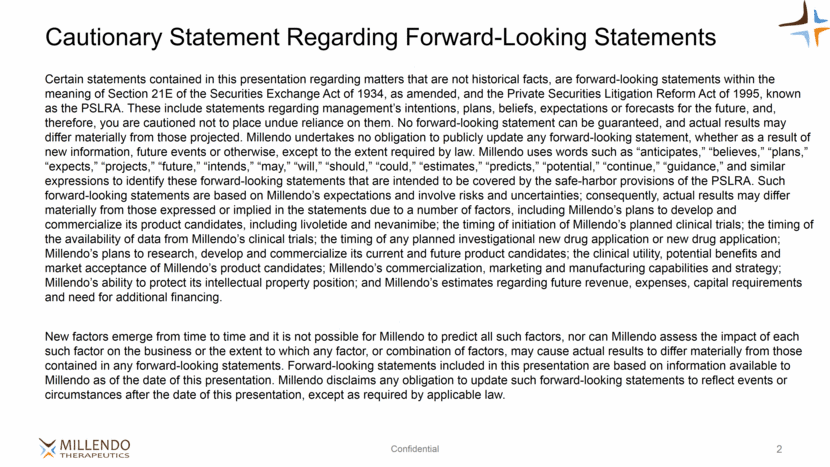
Millendo Therapeutics Leading orphan endocrine disease company Clinical-stage company focused on orphan endocrine diseases Clinically-validated molecules with differentiated mechanisms High unmet medical needs in orphan indications Proceeds of $85M from merger with OvaScience and associated financing Sufficient cash runway to support operations beyond anticipated clinical results in 1H20 STRONG CASH POSITION A LEADER IN ORPHAN ENDOCRINE DISEASES Strong leadership in place to execute on company strategy World-class management team with highly relevant scientific, clinical, regulatory and commercial expertise EXPERIENCED TEAM 3 FIRST-IN-CLASS PROGRAMS 3 Nevanimibe: Multiple Phase 2 trials for serious adrenal diseases Congenital adrenal hyperplasia: POC in Phase 2; Phase 2b initiated in 3Q18 Cushing’s syndrome: Phase 2 study enrolling Livoletide: Pivotal-stage asset for Prader-Willi syndrome Positive placebo-controlled Phase 2 clinical trial in PWS demonstrated reductions in hyperphagia and negative food related behaviors Pivotal Phase 2b/3 study initiating in 1Q19
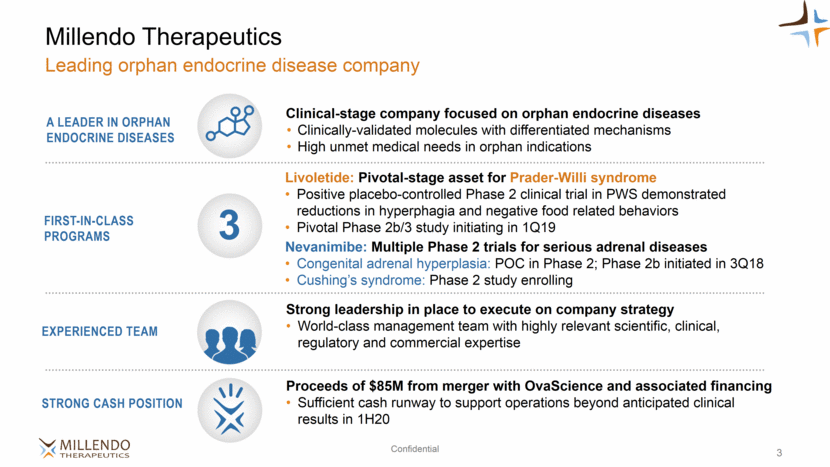
JULIA OWENS, PhD Chief Executive Officer LOUIS ARCUDI III Chief Financial Officer JEFF BRINZA Chief Administrative Officer & General Counsel PHARIS MOHIDEEN, MD Chief Medical Officer THOMAS HOOVER SVP Commercial Strategy Ryan Zeidan, PhD SVP Development ANDREW SPENCER, PhD SVP Preclinical R&D Millendo Executive Leadership Relevant and successful drug development and commercialization expertise 4
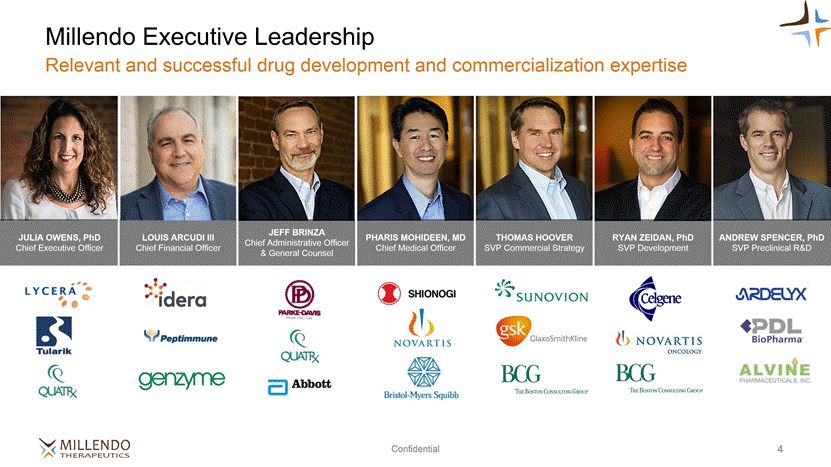
Product Candidate Indication Preclinical Phase 1 Phase 2 Phase 2b Phase 3 Livoletide (AZP-531) Prader-Willi Syndrome (PWS) Nevanimibe (ATR-101) Congenital Adrenal Hyperplasia (CAH) Endogenous Cushing’s Syndrome (CS) Compelling Orphan Endocrine Disease Pipeline Multiple late-stage programs in areas of high unmet need 5 Phase 2b portion of livoletide Phase 2b/3 trial may support submission of NDA
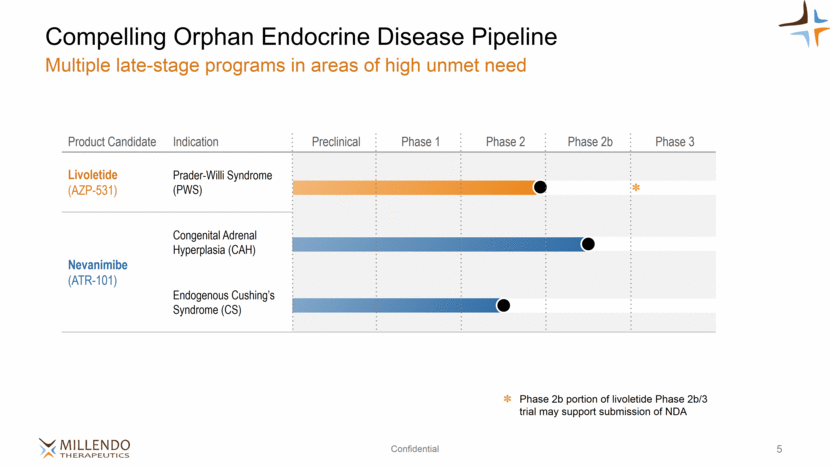
Livoletide (AZP-531) for Prader-Willi Syndrome

Prader-Willi Syndrome (PWS) Well-characterized genetic orphan endocrine disease Prader-Willi syndrome is characterized by: Hyperphagia: Chronic feeling of insatiable hunger Starts at 5-8 years old and usually lasts until death Hallmark of PWS Intellectual/emotional disabilities and psychiatric disorders Multiple hormonal deficiencies resulting in short stature and incomplete sexual development Metabolic dysfunction and early death 7 1 Lionti, 2015 2 Ehara, 1995 Complex disorder attributed primarily to spontaneous genetic error on chromosome 15 Livoletide Nevanimibe 8,000–11,000 13,000–18,000 ~1:15,000 BIRTH INCIDENCE1,2 30-40 years MEDIAN AGE / MORTALITY PREVALENT CASES U.S. EUROPE
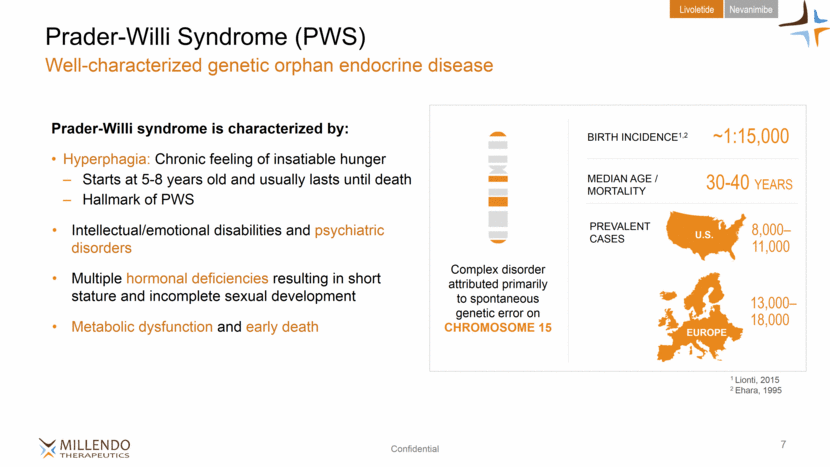
8 PWS Patients and Families Have Significant Needs Almost all Prader-Willi syndrome patients suffer from hyperphagia Livoletide Nevanimibe Hyperphagia is root cause of morbidity and mortality Abnormally high appetite leading to overeating and eventual metabolic issues Leads to patient accidents, which are a significant cause of death Intervention and strict controls necessary, including locking refrigerators and cabinets Burden on caregivers is significant Patients exhibit hyperphagia, high anxiety and lack of emotional control Current treatments focus on other symptoms and don’t address hyperphagia Including hGH “Assuming there is no complete cure for PWS, what specific things would you look for in an ideal treatment for PWS?” Adults with PWS Not at all important Somewhat important Very important Most important 779 respondents (92.5% parents) BMI >40 >50% TYPE 2 DIABETES 25% 0% 10% 20% 30% 40% 50% 60% 70% 80% Reduce hyperphagia Causes weight loss Improves metabolism
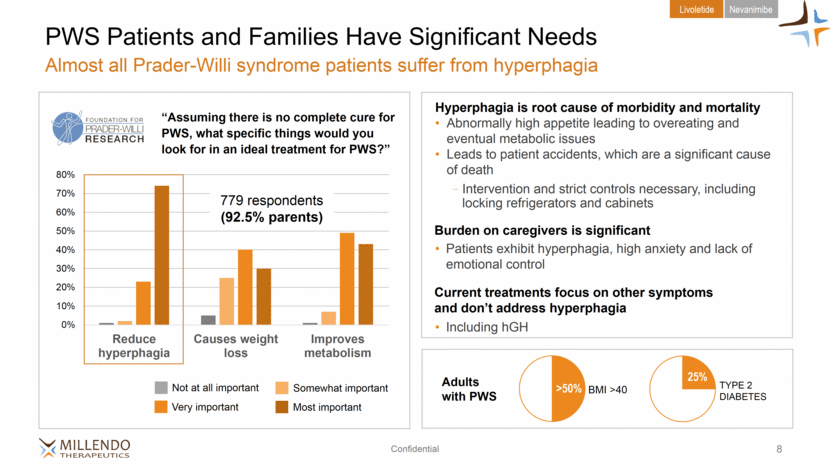
Livoletide Nevanimibe P Critical Need for PWS Treatments Livoletide is a compelling late-stage development drug candidate Well-defined development and regulatory path Livoletide is ready for a pivotal study initiating 1Q19 Beloranib Phase 3 program is useful precedent Novel compound and mechanism for PWS Randomized, double-blind, placebo-controlled Phase 2 clinical trial demonstrated safety and efficacy Favorable safety profile based on clinical and pre-clinical studies to date IP protection until 2033 with potential for extensions Both FDA and EMA understand the large unmet medical need for PWS Validated clinical endpoint – Hyperphagia Questionnaire (HQ)* Acceptable as the sole primary endpoint for PWS trials by FDA and EMA Orphan drug designation granted by U.S. FDA and EMA Benchmark for clinically meaningful results in HQ Reference for recruitment and trial statistics; experienced clinical sites Program terminated in Phase 3 due to safety issues (patient deaths) related to beloranib’s mechanism of action 9 * HQ is a 9-item, validated behavioral questionnaire to assess food-related behaviors and administered to caregivers.
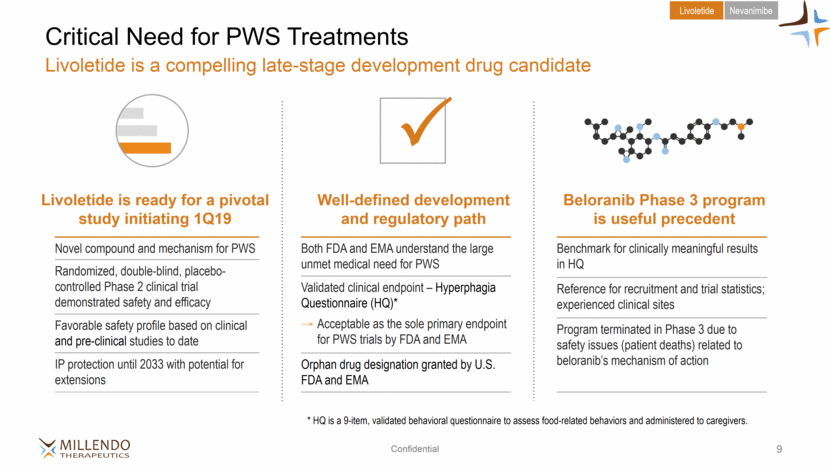
10 Livoletide for Treatment of Hyperphagia in PWS Pharmacology of UAG is distinct from that of AG Livoletide Nevanimibe Livoletide Unacylated Ghrelin (UAG) Acylated Ghrelin (AG) Once-daily injectable cyclic peptide Comparable in vitro and in vivo pharmacological profiles to UAG More stable than linear analogues in human plasma and has improved in vivo PK 1GHSR1a = growth hormone secretagogue receptor, or ghrelin receptor 1 AG is the most potent known appetite-stimulating endocrine hormone Stimulates fat deposition Induces insulin resistance Inhibits AG-induced food intake Modulates food intake () and metabolic endpoints in rodents out to 44 weeks Inhibits fat deposition Improves insulin sensitivity
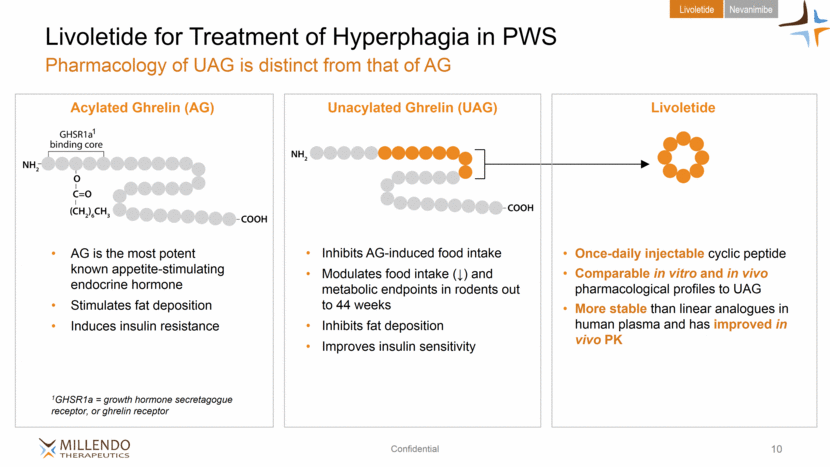
11 Lower Relative UAG Levels Associated with PWS Hyperphagia Livoletide Nevanimibe Median UAG and AG Fall as Hyperphagia Develops AG and UAG in PWS Nutritional Phases Adapted from Kuppens, 2015 pg/mL Nutritional Phase Nutritional Phase Characteristics: Phase 1a: Hypotonia with difficulty feeding Phase 1b: No difficulty feeding and growing appropriately on the growth curve Phase 2a: Weight increasing without an increase in appetite or excessive calories Phase 2b: Weight increasing with an increase in appetite Phase 3: Hyperphagic, rarely feels full Adapted from Miller et al., 2011 Increased appetite and hyperphagia Acylated Ghrelin (AG) Unacylated Ghrelin (UAG) AG is elevated and relative amount of UAG is lower in hyperphagic phases of PWS 0 50 100 150 200 250 300 350 400 Phase 1a Phase 1b Phase 2a Phase 2b Phase 3 Healthy Obese
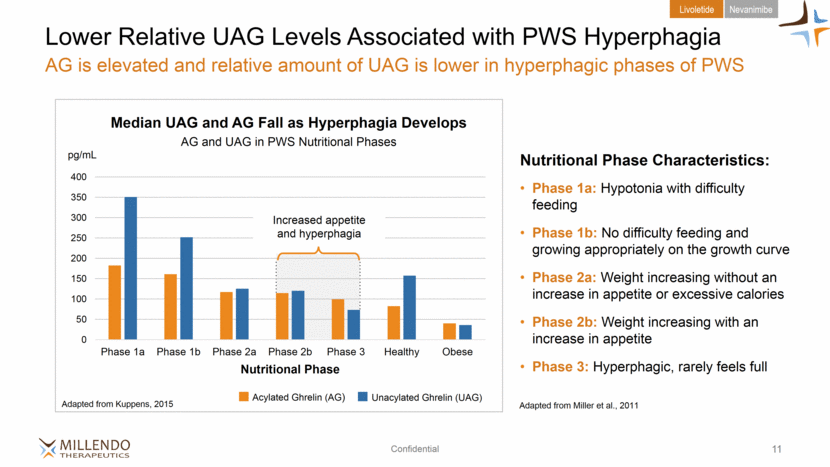
P Phase 1 study Single ascending dose (N=44) in healthy volunteers Multiple ascending dose (N=32) in overweight / obese adults Decreases in glucose and body weight Multiple ascending dose (N=36) in Type 2 diabetes patients Double-blind, placebo-controlled Phase 2 clinical trial in PWS completed (7 European sites) 47 patients with 2 weeks treatment Clinically meaningful results on efficacy measures Well tolerated in clinical testing to date, across 150+ subjects Safety events in Phase 2 study well balanced relative to placebo Subjects reporting any AE: livoletide 60.9% vs. placebo 58.3% Most commonly reported AE in both groups was related to injection site No SAE or discontinuations due to AE Livoletide has a favorable nonclinical safety profile No systemic adverse effects across toxicology program including chronic studies up to 9 months Robust Development Program Significant clinical experience for orphan indication 12 Livoletide Nevanimibe P P P
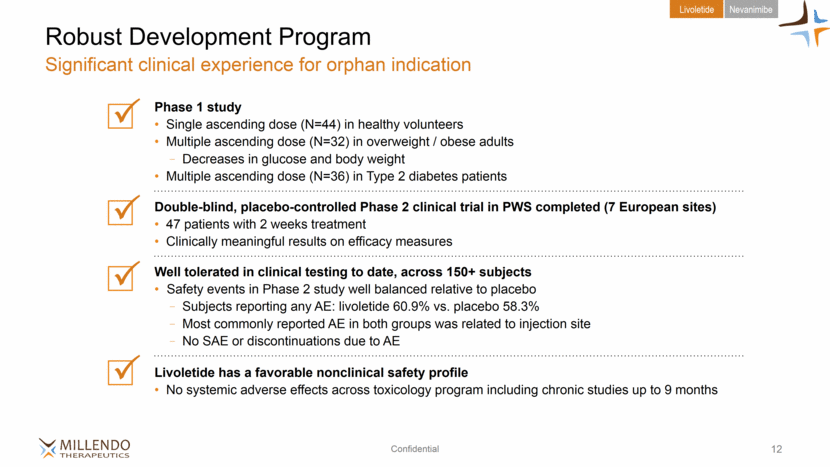
13 2-week Placebo-Controlled Phase 2 PWS Clinical Trial Robust, meaningful decreases in Hyperphagia Questionnaire (HQ) p = 0.097 24 23 20 18 12 14 p = 0.034 p = 0.019 BL = baseline HQ score (adjusted for 0-36 scale) 1 Home residents excludes subjects residing in hospital setting; analysis was pre-specified placebo livoletide 4 mg BL = 12.2 14.1 BL = 12.6 14.8 BL = 17.3 17.9 Allas et al., 2018 Change in HQ from baseline Change in HQ from baseline Change in HQ from baseline Livoletide Nevanimibe Similar to the target patient population for pivotal study - 1.6 - 4.3 -7 -6 -5 -4 -3 -2 -1 0 All Subjects - 1.6 - 5.1 -7 -6 -5 -4 -3 -2 -1 0 Home Residents 1 - 1.0 - 6.2 -7 -6 -5 -4 -3 -2 -1 0 Home Residents BL > 10

14 Livoletide Demonstrated Similar Effect to Beloranib Similar HQ decreases observed with livoletide Livoletide Phase 2 Results (2 weeks) Beloranib Phase 3 Results (4 weeks) McCandless et al., Diabetes Obes Metab (2017) 19:1751-61 *1.8 mg for week 1-4; then 2.4 mg for week 5-26 Inclusion criteria of baseline HQ score >13 on 0-36 scale Baseline: placebo = 15.0; 1.8 mg = 17.4; 2.4 mg = 18.3 Home residents with baseline HQ score of >10 based on 0-36 scale (equivalent to HQ score >19 on 9-45 scale) Baseline: placebo = 17.3; livoletide = 17.9 Change in Hyperphagia Questionnaire Score Change in Hyperphagia Questionnaire Score Livoletide Nevanimibe Placebo (n=12) 4 mg (n=14) Placebo (n=34) 1.8 mg (n=36) 2.4 mg* (n=37) -7 -6 -5 -4 -3 -2 -1 0 -7 -6 -5 -4 -3 -2 -1 0
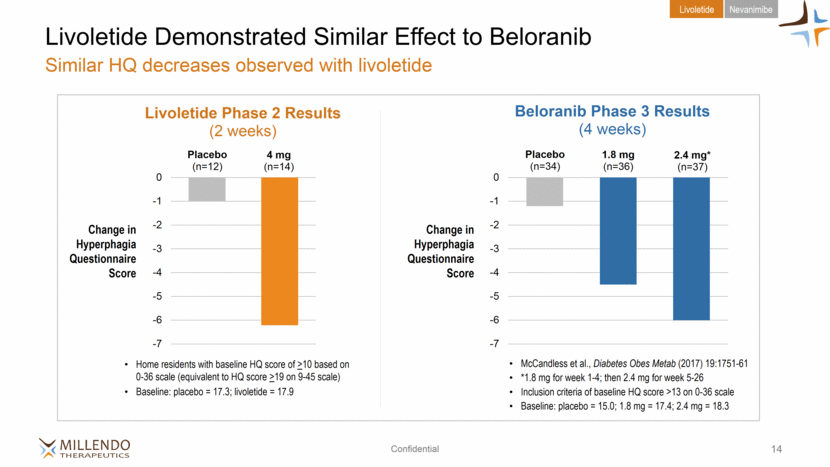
Livoletide PWS Pivotal Study 15 Single, pivotal Phase 2b/3 protocol Placebo (n~40) livoletide (n~40) Phase 2b Phase 3 Placebo crossover / 9-month extension Placebo crossover / 6-month extension 3 month endpoint 6 month endpoint Livoletide Nevanimibe Placebo (n=50) 60 mg/kg livoletide* (n=50) 120 mg/kg livoletide (n=50) Robust dataset: randomized, double-blind, placebo-controlled Primary endpoint HQ-CT PWS patients 8-65 years of age ~35 sites in U.S. and EU Phase 2b portion of study may be able to support NDA submission Initiating 1Q19 with data expected by 1H20 Long-term safety extensions will provide up to 12 months of exposure Phase 3 portion will Assess longer-term durability of effect for hyperphagia Assess metabolic endpoints that may require longer exposures Provide flexibility to adjust endpoints and patient population based on Phase 2b results * 60 mg/kg livoletide is similar to the dose studied in Phase 2 ClinicalTrials.gov Identifier: NCT03790865
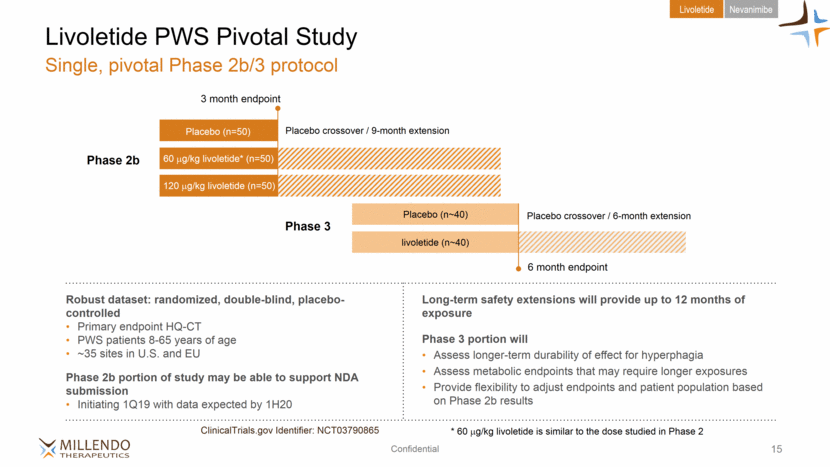
Nevanimibe (ATR-101) for Orphan Adrenal Diseases
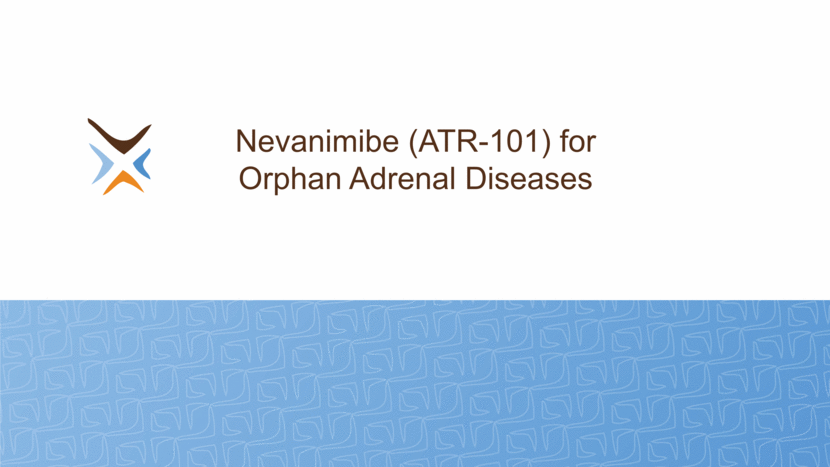
Clinical Proof of Concept Clinical proof-of-concept from open-label Phase 2 clinical trial in CAH Favorable safety profile in preclinical and clinical studies Well-defined mechanism of action Clinical Trials Underway Phase 2b clinical trial in CAH started in 3Q18 Orphan drug designation granted by U.S. FDA and EMA Phase 2 clinical trial in CS ongoing for potential expanded indication Livoletide Nevanimibe Nevanimibe for Congenital Adrenal Hyperplasia Novel MOA has potential to address serious adrenal disease CAH Ph2b CS Ph2 17 P CAH is a MONOGENIC DEFICIENCY diagnosed at birth as part of universal screening 15,000–18,000 ~40,000 CAH PREVALENT CASES U.S. EUROPE
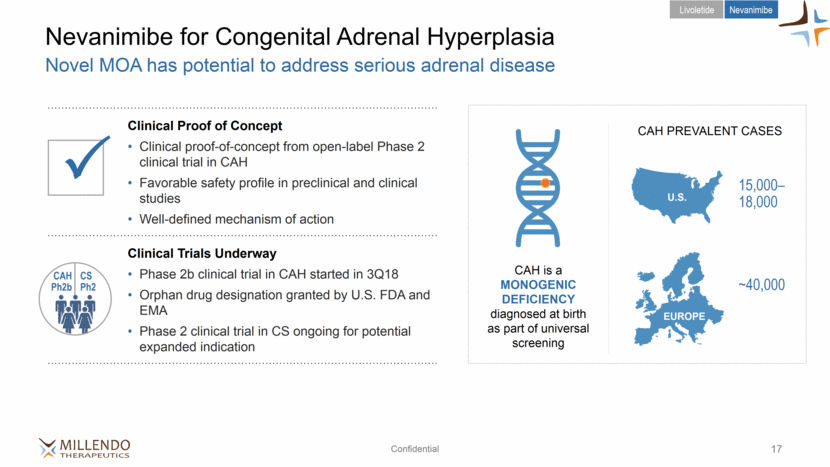
18 Nevanimibe Targets Starting Point of Adrenal Steroid Synthesis Able to inhibit all steroidogenic pathways Livoletide Nevanimibe Congenital Adrenal Hyperplasia (CAH): Inactive 21-hydroxylase leading to elevated androgens and precursors X X
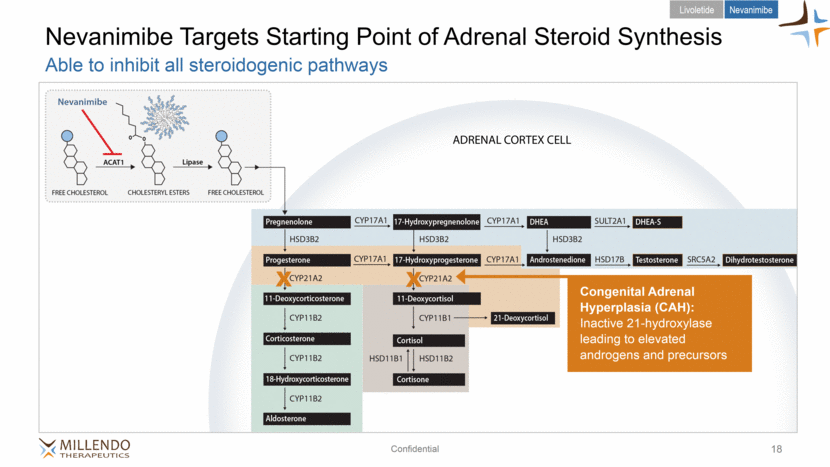
19 CAH Has Lifelong Impacts Results from excess androgens or excess cortisol caused by over or undertreatment Arlt, Endocrine Research, 2010 Jenkin-Jones, European Journal of Endocrinology, 2018 Hagenfeldt, Human Reproduction, 2008 Finkielstain, Endocrine Care, 2012 Falhammar, European Journal of Endocrinology, 2014 childhood teen adult Hormonal imbalance from over or undertreatment of CAH Ambiguous genitalia Short stature Hyper-androgenism Reduced fertility Mental health issues Cushingoid symptoms Early mortality 69% of women have undergone genital reconstructive surgery1 Early and shortened puberty leads to short stature 14 cm for males 10 cm for females1 56% of women reported a history of hirsutism4 26% pregnancy rate vs. 66% for controls3 28% higher incidence of depression vs controls1 Suicidality 2.8% in CAH males vs. 1.2% in controls5 Higher rates than controls of insulin resistance, obesity, and hypertension4 6x adjusted mortality hazard ratio2 Livoletide Nevanimibe

20 Nevanimibe Proof of Concept Established in CAH Activity demonstrated through reductions in 17-OHP Livoletide Nevanimibe P P Mean change in 17-OHP by Study Visit (V) 125 mg BID 250 mg BID 500 mg BID 750 mg BID 1000 mg BID Visits 1-4 n=10; Visits 5-7 n=9; Visits 8-13 n=8 17-OHP (ng/dL) nevanimibe placebo Phase 2 Study Design Intrasubject dose escalation study 2-week treatment and placebo periods Biological effect demonstrated through reduction in key steroids and steroid precursors Mean reductions in 17-OHP were observed at all nevanimibe doses while mean increases were observed during all placebo treatments 7 of 10 of subjects demonstrated a biological effect 2 of 10 subjects met the primary endpoint (17-OHP < 2x ULN) Nevanimibe was reported to be well tolerated P -3,000 -2,000 -1,000 0 1,000 2,000 3,000 V1 V2 V3 V4 V5 V6 V7 V8 V9 V10 V11 V12 V13
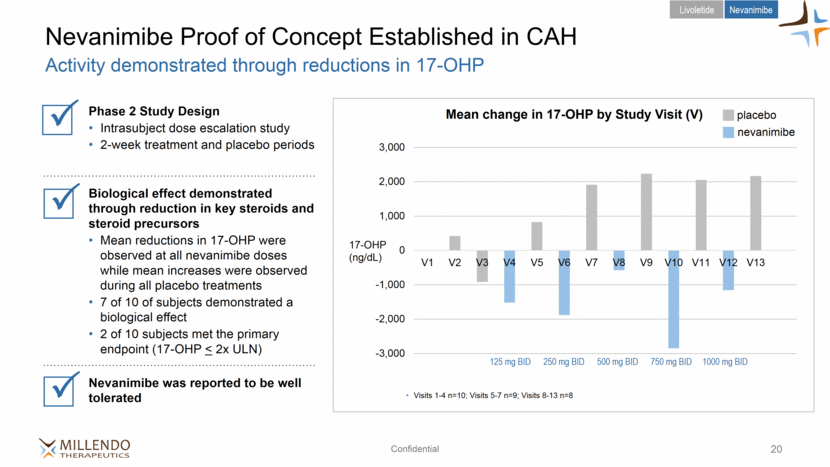
Phase 2b CAH study includes further dose ranging and 3 month continuous dosing Study initiated in 3Q18 21 Nevanimibe CAH Phase 2b Study Overview Intrasubject dose escalation with 3 months continuous dosing Livoletide Nevanimibe 3 MONTHS OF CONTINUOUS nevanimibe DOSING Primary Endpoint 17-OHP < 2x ULN 1000 mg BID, 1500 mg BID and 2000 mg BID Dose titration based on 17-OHP levels n=20-24 ~10 sites ClinicalTrials.gov Identifier: NCT03669549

Corporate

3Q18 Nevanimibe Phase 2b CAH study initiation 4Q18 Public listing (MLND) and financing with total proceeds of $85M 1Q19 Livoletide pivotal Phase 2b/3 PWS study initiation 2Q19 Establish commercial organization in Boston area 2H19 Nevanimibe Phase 2b CAH study update 1H20 Nevanimibe Phase 2b CAH study topline results 1H20 Livoletide Phase 2b PWS study topline results 23 Significant Potential Value Creation Meaningful corporate and clinical milestones over the next 12-18 months P P
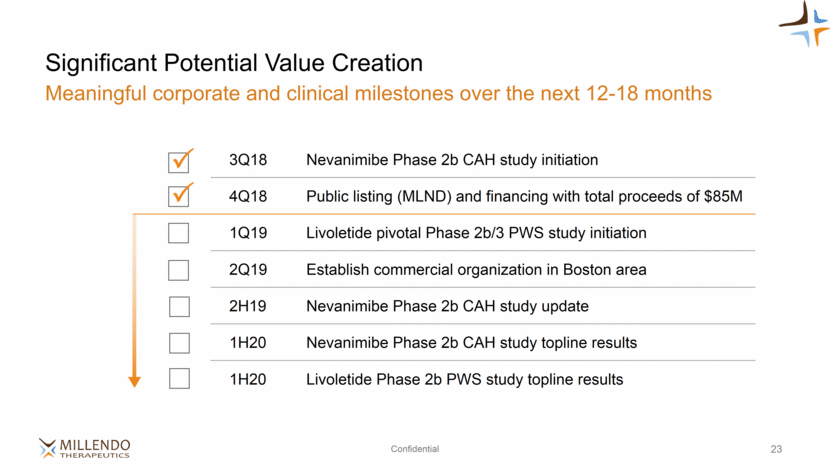
Pursue development of, obtain approval for, and commercialize nevanimibe for the treatment of CAH Continue to expand our pipeline by leveraging our expertise in in-licensing and acquiring product candidates Build a specialized sales and marketing organization in the United States targeting endocrinologists Maximize the value of our portfolio by strategically collaborating in select markets Rapidly and efficiently advance development of, obtain approval for, and commercialize livoletide for the treatment of PWS 24 Millendo is a Leading Company in Rare Endocrine Diseases Novel agents in orphan diseases with significant unmet needs
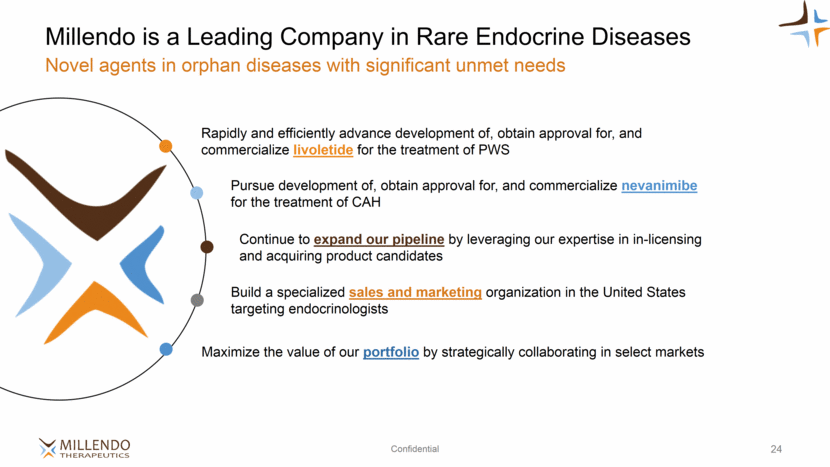
[LOGO]
